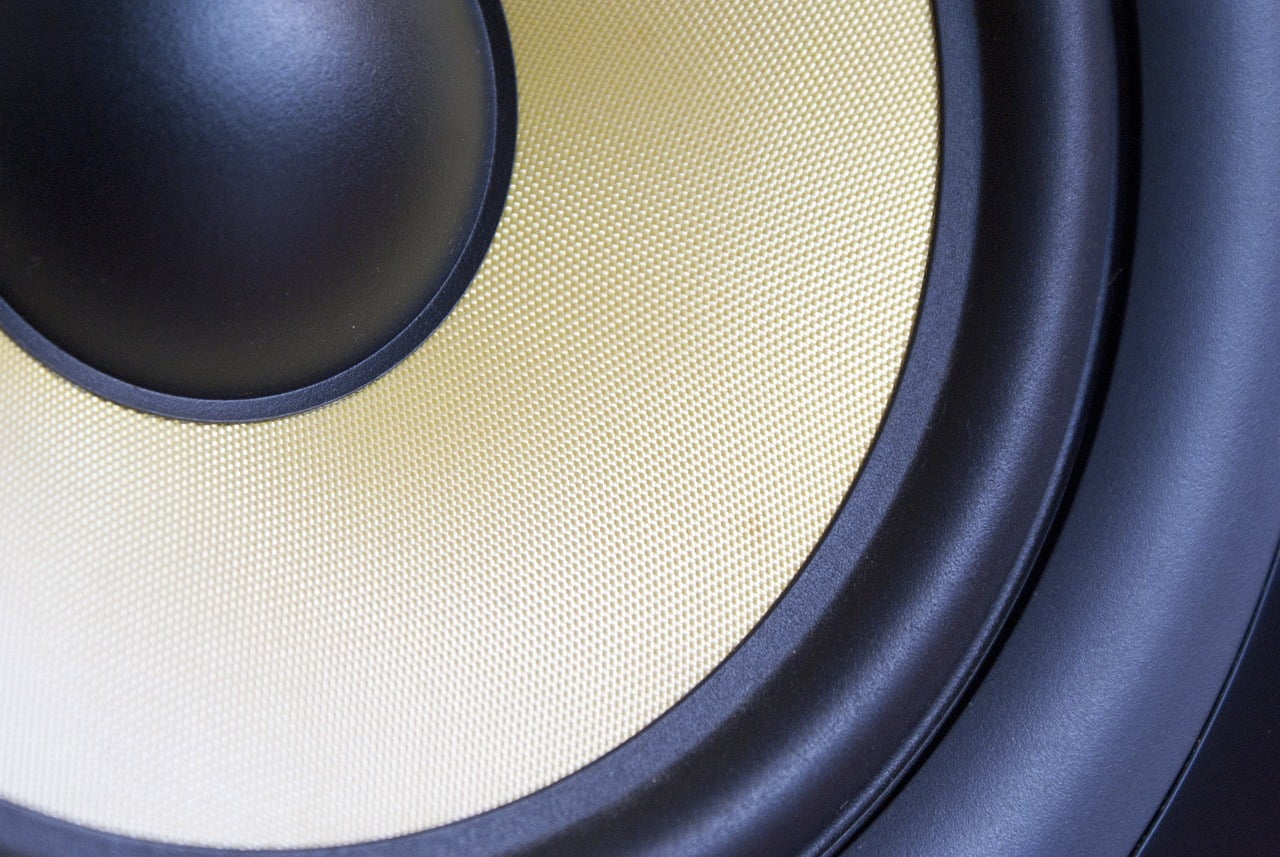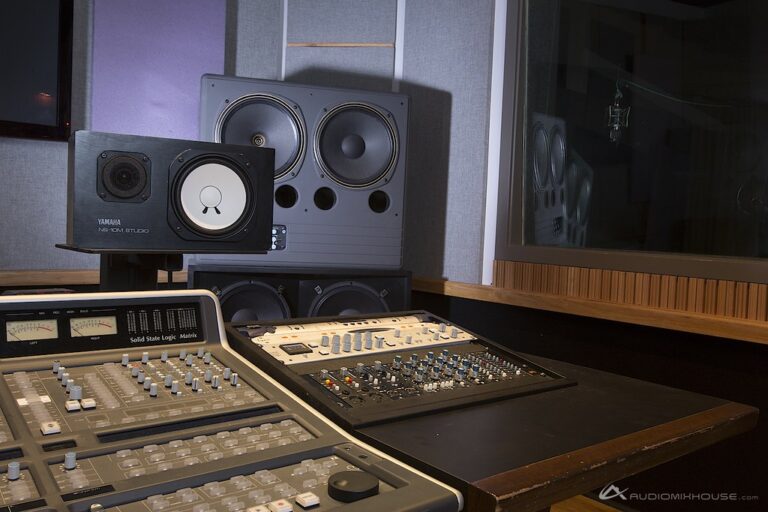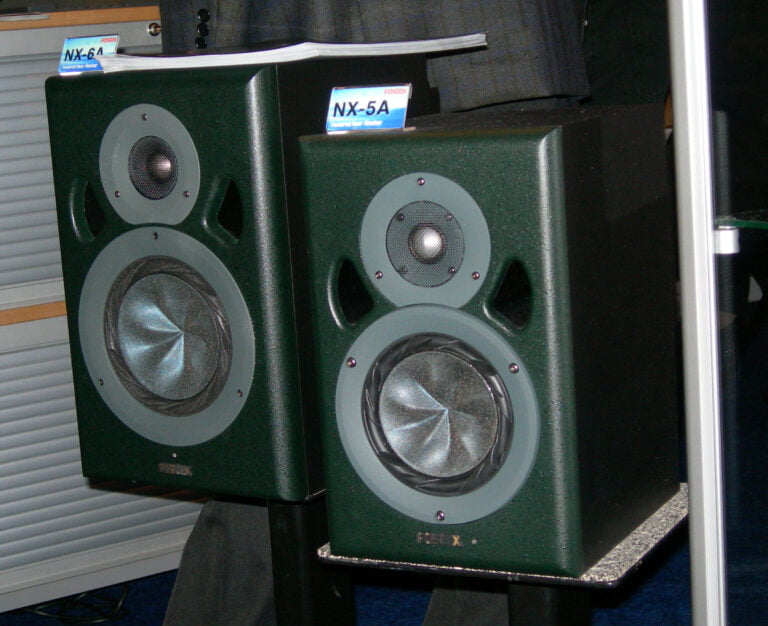Understanding Studio Monitor Specifications: A Comprehensive Guide
Understanding studio monitor specifications is key for achieving precise sound reproduction in studios. Two-way monitors feature a woofer and tweeter for balanced sound, while three-way systems add a midrange driver for enhanced accuracy. Cabinet design, including materials like MDF and plywood, impacts resonance and distortion. Sealed speakers prevent woofer bouncing, ensuring accurate bass response. Select monitors based on room size and acoustic treatment needs to optimize sound quality. Multi-way systems use multiple drivers for precise frequency division, enhancing sound fidelity. Explore more about driver configurations and best sound quality factors for better studio monitoring results.
We are supported by our audience. When you purchase through links on our site, we may earn an affiliate commission, at no extra cost for you. Learn more.
Speaker System Types and Configurations
When selecting studio monitors, understanding the different speaker system types and configurations is essential for achieving accurate sound reproduction. Studio monitors come in various configurations, with one of the most common being two-way speakers. These typically consist of a woofer for low frequencies and a tweeter for high frequencies. While two-way speakers are prevalent and offer a good balance of sound, they may lack in midrange accuracy compared to three-way monitors.
Three-way monitors, on the other hand, incorporate a midrange driver in addition to the woofer and tweeter. This configuration enhances the midrange accuracy, making them ideal for critical listening and mixing tasks. The inclusion of a dedicated midrange driver ensures a more detailed and precise sound reproduction across the frequency spectrum. For example, the Barefoot MM45 monitors utilize multiple midrange drivers to achieve faster response times and improved clarity in the midrange frequencies.
In terms of bass response, the design of the speaker cabinets plays a significant role. Sealed speaker cabinets prevent woofer bouncing, resulting in more accurate bass reproduction. Additionally, sealed cabinets exhibit a shallower roll-off of lows compared to ported designs, ensuring a more controlled and tight bass response. Understanding these speaker system types and configurations is crucial for selecting studio monitors that best suit your audio production needs.
Importance of Cabinet Design
When considering studio monitor specifications, the cabinet design plays a pivotal role in shaping the monitor’s sound characteristics. The material used, the cabinet’s internal bracing, and its shape all contribute to the overall performance of the monitor. Understanding how these factors impact resonance, distortion, and internal acoustic reflections is essential for achieving accurate sound reproduction.
Cabinet Material Impact
Cabinet material selection greatly impacts the sound reproduction quality of studio monitors by influencing resonance, coloration, and overall frequency response. When considering cabinet materials, options like MDF, plywood, and aluminum offer distinct characteristics. Here’s how different materials impact sound quality:
- MDF: Known for its density, MDF minimizes cabinet resonances, providing a neutral sound.
- Plywood: Offers a balanced sound profile with natural warmth, reducing coloration effects.
- Aluminum: Stiffer than wood, aluminum cabinets reduce vibrations, resulting in clearer sound reproduction. Incorporating internal bracing in cabinet design further enhances speaker performance by reducing unwanted resonances and maintaining accurate audio reproduction.
Resonance and Distortion
The impact of resonance and distortion levels in studio monitors is greatly influenced by the design of their cabinets. Sealed enclosures are effective in minimizing cabinet resonances, resulting in cleaner sound reproduction. On the other hand, ported enclosures, while offering extended low-frequency response, can introduce resonances that affect sound accuracy. Passive radiator designs provide a middle ground by helping to control resonances while enhancing low-frequency extension. Understanding cabinet design is important for minimizing distortion and achieving accurate sound representation. By selecting the appropriate enclosure type and design features, such as bracing and damping materials, one can greatly improve the overall performance of studio monitors. This attention to detail guarantees a more precise and faithful sound reproduction for critical listening applications.
Internal Acoustic Reflections
Minimizing internal acoustic reflections is essential in achieving ideal sound quality and frequency response in studio monitors. When considering cabinet design for studio monitors, the following points should be taken into account:
- Sealed enclosures: These help minimize internal reflections, resulting in cleaner and more accurate audio reproduction.
- Ported enclosures: While offering benefits like extended bass response through bass reflex, they can introduce internal resonances and coloration due to air movement.
- Properly designed cabinets: They play a critical role in reducing unwanted reflections that can distort the original sound, enhancing the overall acoustic performance of studio monitors. Understanding these aspects aids in selecting monitors with optimal internal acoustic performance.
Selecting Monitors Based on Room
When choosing studio monitors, it’s essential to take into account the room size, shape, and acoustics for ideal sound reproduction. The positioning of monitors within the room plays a significant role in sound quality and frequency response. Furthermore, employing room treatments like acoustic panels and bass traps can improve monitor performance by addressing room-specific acoustic challenges.
Room Size Consideration
Taking room size into account when selecting studio monitors is crucial for achieving ideal sound reproduction. To guarantee balanced sound and accurate representation, follow these guidelines:
- Monitor Size Selection:
- For small rooms, choose smaller monitors to prevent overwhelming bass response.
- In larger rooms, opt for bigger monitors for ample volume and bass output.
- Monitor Type Consideration:
- Choose near-field monitors for small rooms, allowing for closer listening distances.
- For larger spaces, consider far-field monitors to maintain sound integrity across the room.
- Matching Monitors to Room:
- Aligning monitor size with room dimensions for the best sound reproduction.
Acoustic Treatment Needs
Considering the acoustic treatment needs of a room is vital when selecting studio monitors to ensure ideal sound quality and precision. Room size, dimensions, and materials significantly impact sound reflections and the frequency response of monitors. Implementing acoustic treatments such as bass traps, diffusers, and absorbers can help control room reverberation, ensuring proper room acoustics that enhance monitor performance and accuracy. Matching studio monitors to the specific acoustics of a room is essential for achieving excellent sound quality and a reliable monitoring experience. By addressing the acoustic treatment needs of the room, you can create an environment that maximizes the potential of your studio monitors and allows for accurate audio production.
Speaker Placement Tips
To optimize the performance of studio monitors in a room, strategic speaker placement plays a significant role in achieving accurate sound reproduction. When considering monitor placement based on room characteristics, it is crucial to:
- Position monitors in an equilateral triangle with the listener’s head: This arrangement enhances stereo imaging and guarantees a balanced listening experience.
- Elevate monitors to ear level using speaker stands: By doing so, desk reflections are minimized, leading to improved clarity in the high frequencies.
- Avoid placing monitors directly against walls: This practice helps reduce bass buildup and coloration, resulting in a more precise representation of low frequencies within the room.
Benefits of Sealed Speakers
Sealed speakers excel at preventing woofer bouncing, ensuring highly accurate bass reproduction. Unlike ported designs, sealed speaker cabinets exhibit a shallow roll-off of lows, maintaining superior low-frequency response. This characteristic results in tighter and more controlled bass, which greatly enhances the overall sound quality of the audio output. One of the key advantages of sealed speakers is their ability to minimize phase issues that can arise in other speaker configurations. By reducing rearward sound interference, sealed speakers provide cleaner audio reproduction, making them ideal for critical listening and precise mixing applications.
The unique sound characteristics of sealed monitors, such as the renowned Yamaha NS-10, have made them a popular choice among audio professionals. Their ability to deliver accurate bass without the distortion caused by woofer bouncing ensures that the listener experiences the audio as intended by the creators. This accuracy is particularly important in critical listening environments where every nuance of the sound matters for making informed decisions during the mixing process. Overall, the benefits of sealed speakers lie in their ability to offer controlled bass, minimize phase issues, and provide accurate sound reproduction, making them a valuable tool for any audio professional.
Understanding Driver Configurations
Understanding driver configurations plays an essential role in achieving accurate sound reproduction across the frequency spectrum in studio monitor systems. Different setups such as two-way, three-way, and four-way systems are designed to efficiently divide frequency bands for best performance. Here’s a breakdown of these configurations:
- Two-Way Systems:
- Components: Consist of a woofer and a tweeter.
- Functionality: The woofer handles low frequencies, while the tweeter reproduces high frequencies.
- Advantages: Provides a good balance between bass and treble, suitable for many studio monitoring applications.
- Three-Way Systems:
- Addition: Includes a midrange driver in addition to the woofer and tweeter.
- Role: The midrange driver enhances the accuracy of mid frequencies.
- Benefits: Offers improved frequency response across the spectrum, resulting in more detailed sound reproduction.
- Four-Way Systems:
- Further Division: Divide frequency bands more precisely.
- Components: Typically feature a woofer, midrange, tweeter, and sometimes a super tweeter.
- Precision: Allows for even finer control over different frequency ranges, leading to exceptional clarity in sound reproduction.
The choice of driver configuration plays a vital role in a studio monitor’s ability to reproduce sound faithfully, making it important to select the right setup based on the desired audio performance goals.
Exploring Multi-Way Systems
Exploring the complexities of multi-way speaker systems reveals a world of precise frequency division for enhanced sound fidelity. In these systems, the division of frequencies is achieved by utilizing multiple drivers, each responsible for a specific frequency range. A typical three-way system consists of a woofer for handling low frequencies, a midrange driver for midrange frequencies, and a tweeter dedicated to high frequencies. This setup allows for a more accurate reproduction of sound across the frequency spectrum.
For even more detailed sound reproduction, four-way systems further divide the frequencies, typically incorporating an additional driver to enhance clarity and detail. By dividing the frequencies among multiple drivers, multi-way systems can offer improved frequency separation and reduced distortion compared to simpler two-way systems. However, the complexity of multi-way configurations necessitates meticulous crossover design and precise integration of drivers to ensure optimal performance.
In designing multi-way systems, the crossover plays an important role in directing the appropriate frequencies to the respective drivers. A well-designed crossover ensures smooth transitions between drivers and prevents frequency overlap, resulting in a cohesive and accurate sound output. Achieving a seamless blend between the woofer, midrange driver, and tweeter is essential for creating a balanced and detailed soundstage in multi-way speaker systems.
Tips for Optimal Sound Quality
To achieve ideal sound quality with studio monitors, it is important to prioritize a flat frequency response for precise sound reproduction. Here are key tips to guarantee top-notch sound quality:
- Room Acoustics: Consider the acoustic properties of your room. Use acoustic treatment like bass traps and diffusers to minimize reflections and standing waves that can impact the monitor’s performance.
- Monitor Placement: Proper placement of studio monitors is vital. Position them at ear level in an equilateral triangle with your listening position to guarantee accurate stereo imaging and frequency response.
- Speaker Size and Power Requirements: Choose monitor speakers that suit your room size and power needs. Larger rooms may require bigger speakers with higher power handling to fill the space effectively, while smaller rooms may benefit from compact monitors that deliver clear sound at lower volumes.






